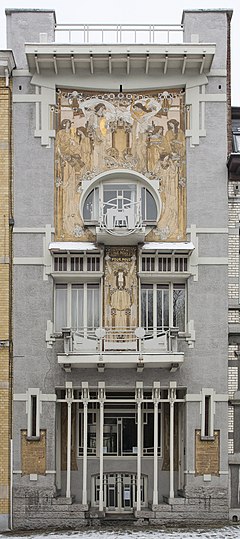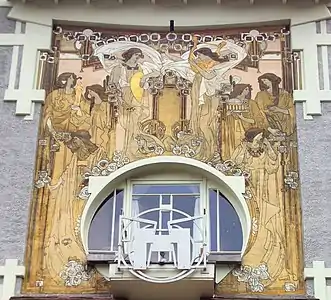Cauchie House
Cauchie House (French: Maison Cauchie, Dutch: Cauchiehuis) is a townhouse in Brussels, Belgium. It was built in 1905 by Art Nouveau architect, painter, and designer Paul Cauchie, in Etterbeek, next to the Cinquantenaire Park. Its facade is remarkable for its allegorical sgraffiti.
| Cauchie House | |
|---|---|
 Main facade of Cauchie House | |

| |
| General information | |
| Architectural style | Art Nouveau |
| Location | Brussels, Belgium |
| Coordinates | 50°50′18″N 4°23′43″E |
| Current tenants | Dessicy Family |
| Completed | 1905 |
| Client | Paul Cauchie |
| Design and construction | |
| Architect | Paul Cauchie |
| Other designers | Caroline Voet |
Background
Paul Cauchie was sixteen when he began his architectural studies at the Antwerp Royal Academy of Fine Arts (in the classes of Joseph Schadde and Léonard Blomme). Very soon afterwards, he enrolled at the Académie Royale des Beaux-Arts (in the class of Constant Montald), where he studied painting (as a pupil of Jean Portaels) and the sgraffito technique, and followed courses in decorative painting (1893–1898). From 1895, whilst still pursuing his studies, Cauchie started to work for a living. Apart from his own house, only three houses built by Cauchie are known: two others in Brussels and one at Duinbergen. As Cauchie was more of a decorator than an architect, he specialised in designing sgraffiti for architecture.
Cauchie met his future wife in the Royal Academy of Fine Arts. Carolina 'Lina' Voet achieved a very good level in painting, enabling her to teach drawing and painting privately. They married in 1905 and decided to build a house on the 6 metres (20 ft)-wide plot of land Cauchie bought next to the Cinquantenaire Park. He designed the front of the house with the intention of advertising and selling their work: sgraffiti for him and art teaching for her. As the house was easily seen from the neighbouring roads, it drew the attention of passers-by and demonstrated their know-how.
Building
At the very centre of the facade, Cauchie drew the words "Par Nous — Pour Nous" (English: By Us — For Us). The house was designed, from the very beginning, as a joint work intended for private use. Cauchie did the drawings for the house but worked together with his wife to design and decorate their home-workshop. Cauchie and his wife filled the house with their multiple works of art (paintings, wall coverings, furniture, etc.)
Cauchie House is a good example of the application of the principle of "total art" in architecture. Cauchie and his wife wanted that the distinction between the main art forms (architecture, painting, sculpture) and the minor art forms (decorative arts) disappeared to become part of the global œuvre.
 Sgraffito by Cauchie on his residence and studio
Sgraffito by Cauchie on his residence and studio Sgraffito panel in Cauchie House
Sgraffito panel in Cauchie House '"Par Nous — Pour Nous" (English: By Us — For Us), a joint work intended for private use
'"Par Nous — Pour Nous" (English: By Us — For Us), a joint work intended for private use
Tintin Museum in Cauchie House
In 1979, the saving of Cauchie House led to the idea of using it to house an Adventures of Tintin museum in cooperation with their creator, Hergé.[1] Symbolically, on Christmas Day, 1980, Hergé gave Dessicy his official agreement to the project. Dessicy undertook an intensive study with Bob De Moor, who laid the bases of the scenography. A scale model was made by the Studios Hergé.
Dessicy started to look for sponsors and supports. In the meantime, he devoted himself to saving another building, the former Magasins Waucquez, work of the Belgian architect Victor Horta. Despite many steps taken to find sponsors, Dessicy did not succeed in creating sufficient interest to complete his project of a Tintin Museum at Cauchie House. Eventually, Desiccy succeeded in turning the Magasins Waucquez into the Belgian Comic Strip Center.
Cauchie House today
The basement, containing the cellars and Paul Cauchie's workshop, has been converted into a vast gallery, exhibiting photos, paintings, and archive documents, meticulously collected over the years by the Maison Cauchie ASBL. They illustrate the stages of the house restoration and the artistic activities of Paul and Lina Cauchie. The ground floor freed of the unfortunate alteration carried out by the successive occupants after Paul's death has recovered its original appearance. The two upper floors of the house have been converted into apartments and renovated in accordance with contemporary needs.
See also
Notes
- "Un musée Tintin permanent dans la maison Cauchie à Etterbeek?". Le Soir (in French). 1982-02-17.
References
- Henricot, Marc; Schudel, Walter (1982). "Traitement de conservation des spraffites de façade de la maison Cauchie à Bruxelles". Bulletin de l'Institut Royal du Patrimoine Artistique (in French). Bruxelles. 19: 26–33.
The outdoor-sgraffito, executed in 1905 after the design of the painter Paul Cauchie (1875-1952), was flaking. The loose layers had to be lifted for securing with poly(vinyl acetate), lime, and caseine.(...)
- Françoise, Aubry (2006). L'architecture en Belgique — Art nouveau, art déco & modernisme (in French). Lannoo Uitgeverij. p. 200. ISBN 2-87386-467-2.
- "Catalog of images of the Cauchie house". Picture Library. Royal Institute for the Study and Conservation of Belgium's Artistic Heritage. Retrieved 2009-01-10.
- "Un musée Tintin permanent dans la maison Cauchie à Etterbeek?". Le Soir (in French). 1982-02-17.
External links
| Wikimedia Commons has media related to Maison Cauchie. |